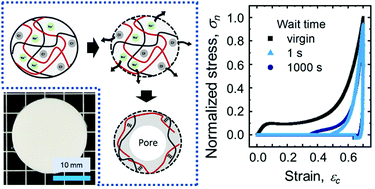Polyelectrolyte complexation via viscoelastic phase separation results in tough and self-recovering porous hydrogels†
Abstract
Polyelectrolyte complexation between oppositely charged polyelectrolytes forms coacervates in dilute solutions and thin films in concentrated solutions. It is difficult to obtain macroscopically uniform bulk polyelectrolyte complex (PEC) materials, since the two polymers form insoluble complexes quickly at the contact interface during mixing, resulting in heterogeneous aggregates. Here, we succeeded in preparing bulk PEC materials based on desalting-induced polyelectrolyte complexation via viscoelastic phase separation. With a high ionic strength aqueous medium, a homogeneous and concentrated solution containing oppositely charged polyelectrolytes is prepared. Desalting of the counter-ions and co-ions of the solution through semi-permeable membranes induces viscoelastic phase separation of the solution to form a physical hydrogel with open pore structure. Regulating the charge ratio of the two oppositely charged polymers results in significant changes in the porous morphology and mechanical properties. The charge-balanced PEC hydrogels show unique properties including high toughness and self-recovery due to the reversible ionic associations. The porous yet tough properties of bulk PEC hydrogels makes them potential candidates for applications such as cell scaffolds.

- This article is part of the themed collection: 2019 Journal of Materials Chemistry B HOT Papers


 Please wait while we load your content...
Please wait while we load your content...